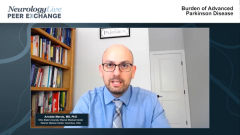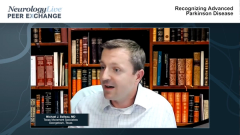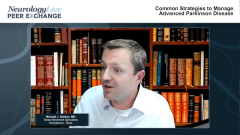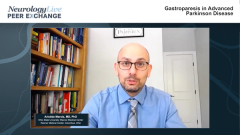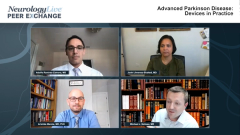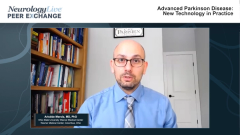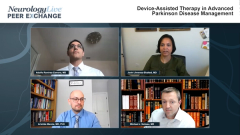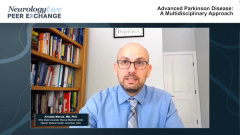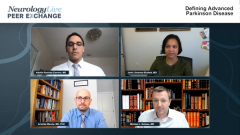
Advanced Parkinson Disease: Devices in Practice
Experts discuss their personal experiences using technology and devices in advanced Parkinson disease management and identify patients that are adequately controlled with therapy.
Episodes in this series

Adolfo Ramirez-Zamora, MD: Michael, do you use apps? There are a few that patients can download to keep track of pills and symptoms, but it requires the patients to access the app, put in information about their state, and then maybe provide a report to the doctor. Do you use that in your practice? In a perfect world, it would be great if we had a cloud system that monitors remotely, that’s 100% accurate, and that gets that information to us right before their visits. That would be really nice. We aren’t there yet, but do you use any of these new technologies that are out there? There is internet-based software that can be used, including obviously the Apple Watch. Do you recommend them at all?
Michael J. Soileau, MD: For all the techies out there, there are some good ideas for new inventions. Adolfo just gave you a big hand with ideas for what’s needed. To answer your question, I don’t use a lot of them, honestly, in my practice in terms of those devices that help to monitor. For example, patients bring forward apps for tremor and try these watches and such that have accelerometers. They can look for whether tremor is there. I like to be very simple and just say, “To prove the point, how is your tremor? Is it there? Is it bothering you?” That way we can objectify it. We can quantify it too. But I feel like that’s a little overkill for the natural purpose of saying, “Are you OFF or ON?”
Where things start to really get interesting is, let’s say a patient falls, and you say, “What were you doing when you fell?” “I don’t know, I was walking, and I went to make a turn, and I fell backward.” “When did you fall? What time?” “I don’t know. Why would I look at the time?” “Was it at the beginning of your dose, in the end, in the middle?” Why does that matter? Because it affects how we troubleshoot your medication. We’ve used this occasionally on 1 of our deep-brain stimulator systems that allows us to have a patient event—we can have them press a button if there’s something we want to track, and then we’re able to go back and look and see when the patient fell. Even more important, we can see what their brain waves or perhaps their OFF state or ON state—if that’s where they were—and what that was doing at the moment they pressed that button.
That becomes more interesting. Did they fall because they were too dyskinetic, and that was at the peak of their therapy? Or did they fall because they were freezing and wearing off? It actually changes my management. But right now, the majority of the things that are commercially available, not in the form of our research studies, don’t really change the management very much. It’s just as useful to ask a caregiver as well as the patient. But I’d also love to hear what others have to say about that, if you all integrated and [implemented] devices into your practice.
Joohi Jimenez-Shahed, MD: Michael, I can take a stab at joining you in that conversation. I agree with you. The available technologies and wearables that we’re talking about that can help track symptoms are challenging to use. They provide information. In some cases, it’s information that still requires a little effort to put it into the context of what’s going on with the patient, and you still need to go back and talk to the patient to figure out what this device is telling us. Does that mirror the experience you’re having? What can you tell me about how this really is for you in your day-to-day life? There’s still a fair amount of work that needs to be done in terms of optimizing those wearables for general use that allows them to be seamlessly integrated into our assessment of the patient.
Adolfo, I completely share your dream that if there’s just a way to have all this information there and at our disposal at the time that we’re seeing a patient, it might facilitate the decision-making that needs to happen for appropriate therapeutic adjustments. Interestingly, I’m working with an engineering collaborator on developing exactly this type of a wearable device, and that can help in a better way to identify when patients are ON, when they’re OFF, when they’re dyskinetic, or when their tremor is present. As Michael was saying, the question you want to know is where [are those symptoms] in the course of your medication? If you can’t understand that relationship, then it still becomes challenging to use the data that are being given to us.
Adolfo Ramirez-Zamora, MD: This is really an interesting conversation. I agree with Michael about the point about knowing about events, especially those like falls, for example, because there are other factors beyond the motor fluctuations that can account for it, right? Were you tripping over because you were shuffling? Are you orthostatic? Did you have low blood pressure because your medications were on and then your blood pressure goes down? Were you just having a peak event when you were a little confused and then you simply lost your balance? Is this the beginning of postural instability? There are all these things, and we know that reporting freezing is difficult.
Every study that tried to report and collect freezing information at home and in clinic, I’m sure we’ve heard the story of the patient who says that he’s freezing a lot and in clinic. Nothing—they walk perfectly, right? And the wife is always saying, “I don’t know what to do. He never walks like this at home. I don’t know what to make of it.” The technology is going to have a niche. It’s going to be really helpful with certain things, but at the same time, knowing that the patient is dyskinetic, but they’re not even aware of it, it has to be put into context. We can never look at these raw numbers and treat based on that. I agree that there’s no algorithm that relies on numbers.
Thank you all for watching this Neurology Live® Peer Exchange. If you enjoyed the content, please subscribe to our e-newsletter to receive upcoming Peer Exchanges and other great content right in your in-box. Thank you so much.
Transcript Edited for Clarity
Newsletter
Keep your finger on the pulse of neurology—subscribe to NeurologyLive for expert interviews, new data, and breakthrough treatment updates.

